How to Use Beef Bones for Stock
This is a classical French-style recipe for homemade beef stock. It's vastly superior to any store-bought stock, and is one of the chief things that distinguishes abode and restaurant cooking.
It takes fourth dimension to make, but if yous truly desire the best, information technology's worth it!
More stocks: craven stock | vegetable stock
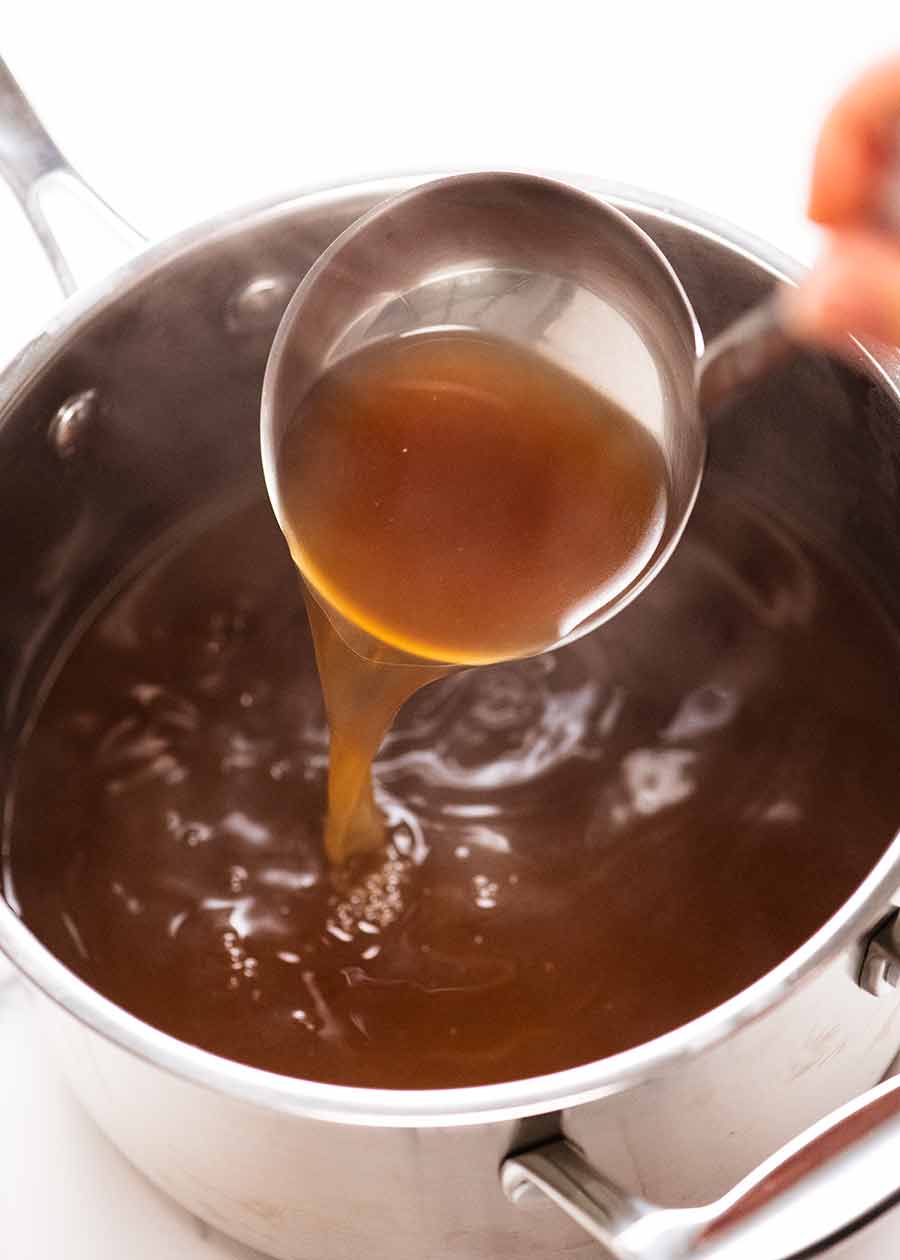
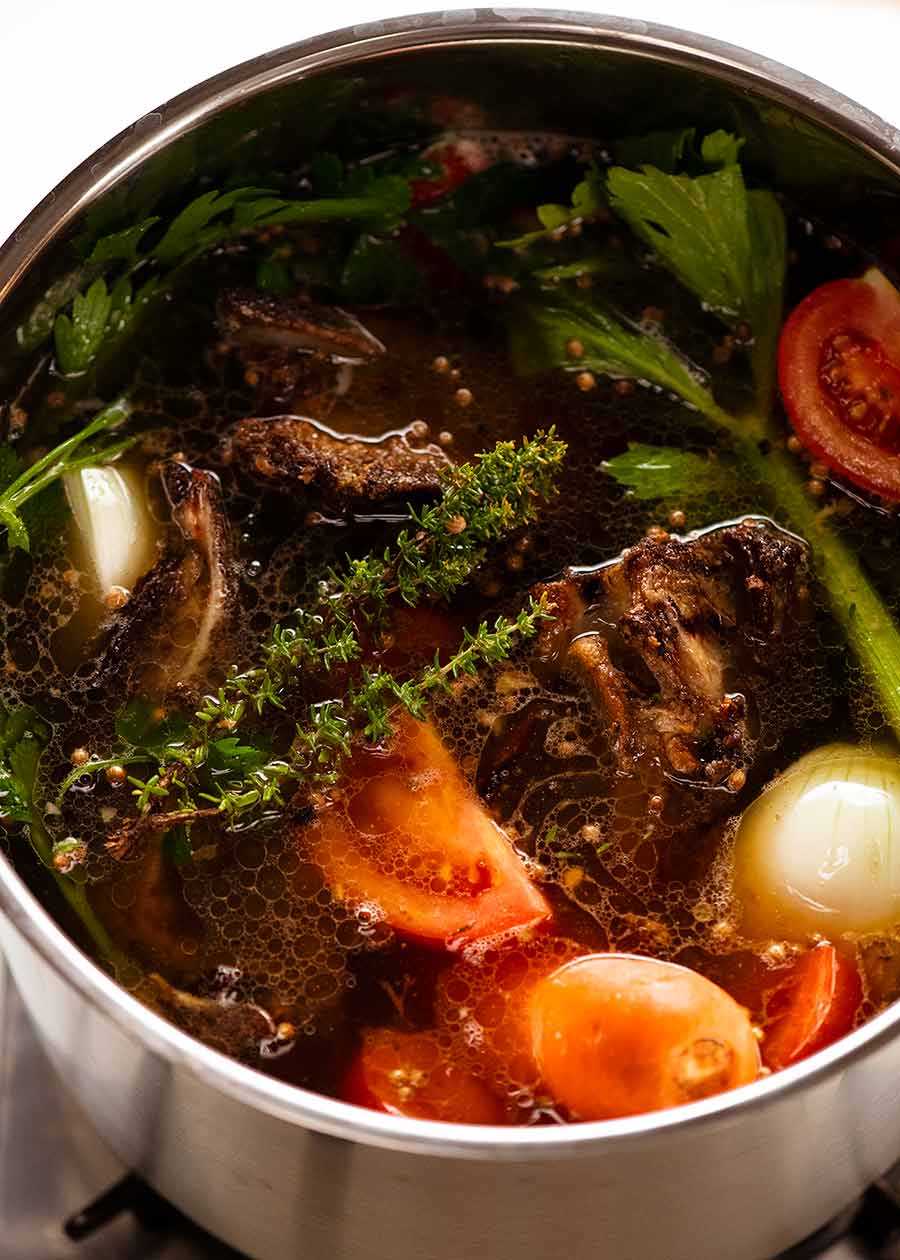
Allow me say from the beginning: bootleg beef stock requires effort. It takes fourth dimension – I'm talking minimum 4 hours, upward to 10 hours is best – there's a pile of hot bones to discard, and large cooking vessels that'll demand cleaning.
And so one might ask:
Why make beefiness stock at home?
Because it is so vastly superior to any store-bought stock. While I think that (most) store bought craven stock is actually pretty expert these days and vegetable stock is passable, beef stock has never been that great.
Homemade beef stock has:
-
Far better flavour – Store bought stock does non compare to existent, freshly made stock. A simple taste is all information technology takes to confirm this;
-
Richer mouthfeel – Gelatin from the basic and connective tissue in beef bones is what gives a stock its full-bodied richness and mouthfeel when used in soups and stews etc, besides as natural thickness when highly reduced for use equally a jus or in sauces. Store-bought stock lacks this quality;
-
More versatile because it's unsalted – Store-bought stock is almost always salted. This is fine when used at normal concentrations, but if stock is reduced a lot when making ragus, sauces and so on, the salt tin become excessive – yet there is little you tin can do about it. Homemade stock on the other paw is unsalted, so you will never have this problem and can control seasoning in the finished dish; and
-
Cheaper than high quality store-bought stocks. Yeah, regular supermarket packet beef stock (eg. Campbell'south) is cheaper than homemade stock. Only information technology also tastes quite artificial, because producers are yet to successfully mass-produce inexpensive beef stock to a decent level of quality. High-cease packaged stocks are better, simply are very expensive by comparison.
Homemade stock is i of the big things that differentiate home and eatery cooking. Proficient restaurants ever brand their own stocks, and is the secret to why their dishes often have that richer, deeper, "restaurant-quality" gustation to them.
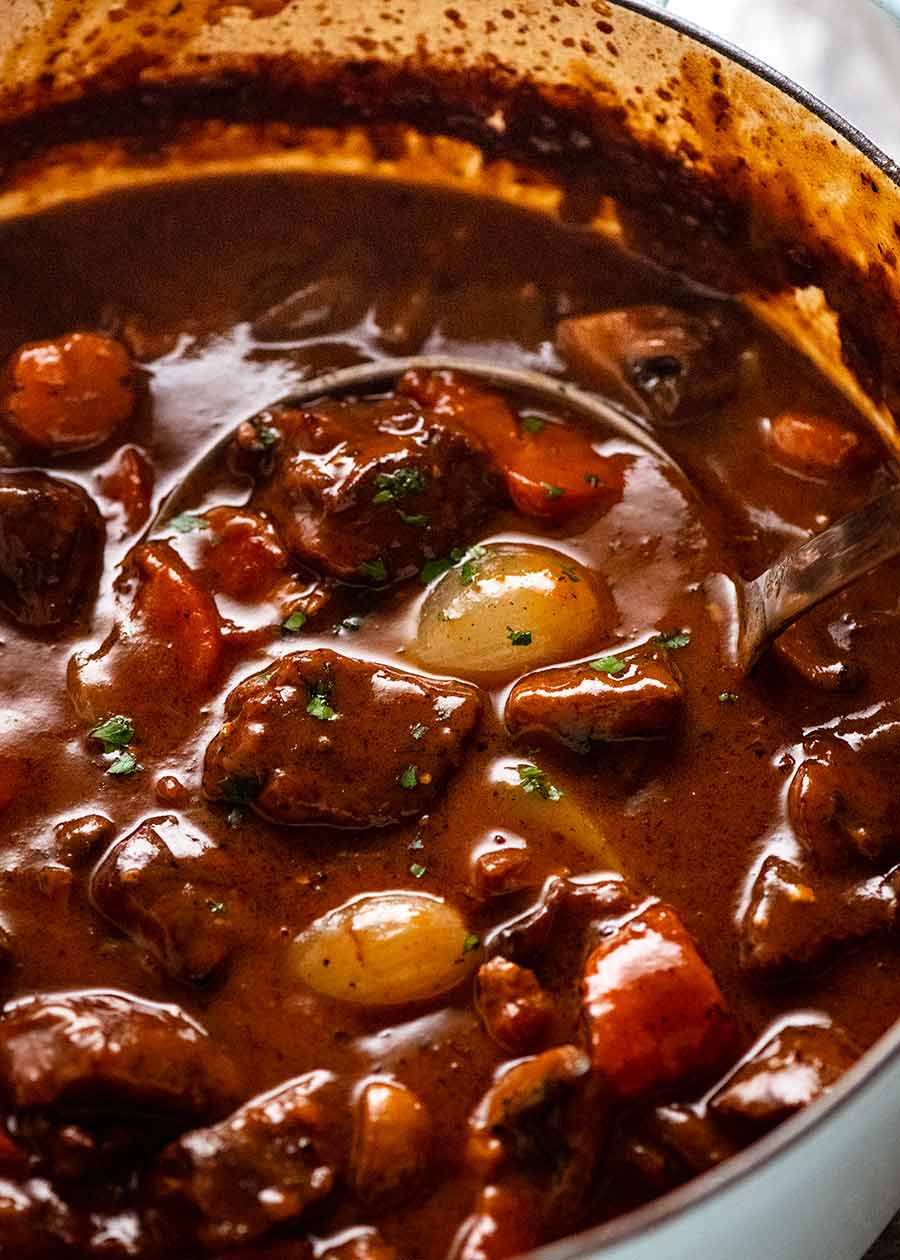
What goes in homemade beef stock
The key ingredient to make a actually adept beef stock is meaty bones. No meat, no season!
You need two ane/2 kg / five lb of beef basic to make 1 i/4 – 1.5 litres / quarts of stock (5 – half dozen cups).
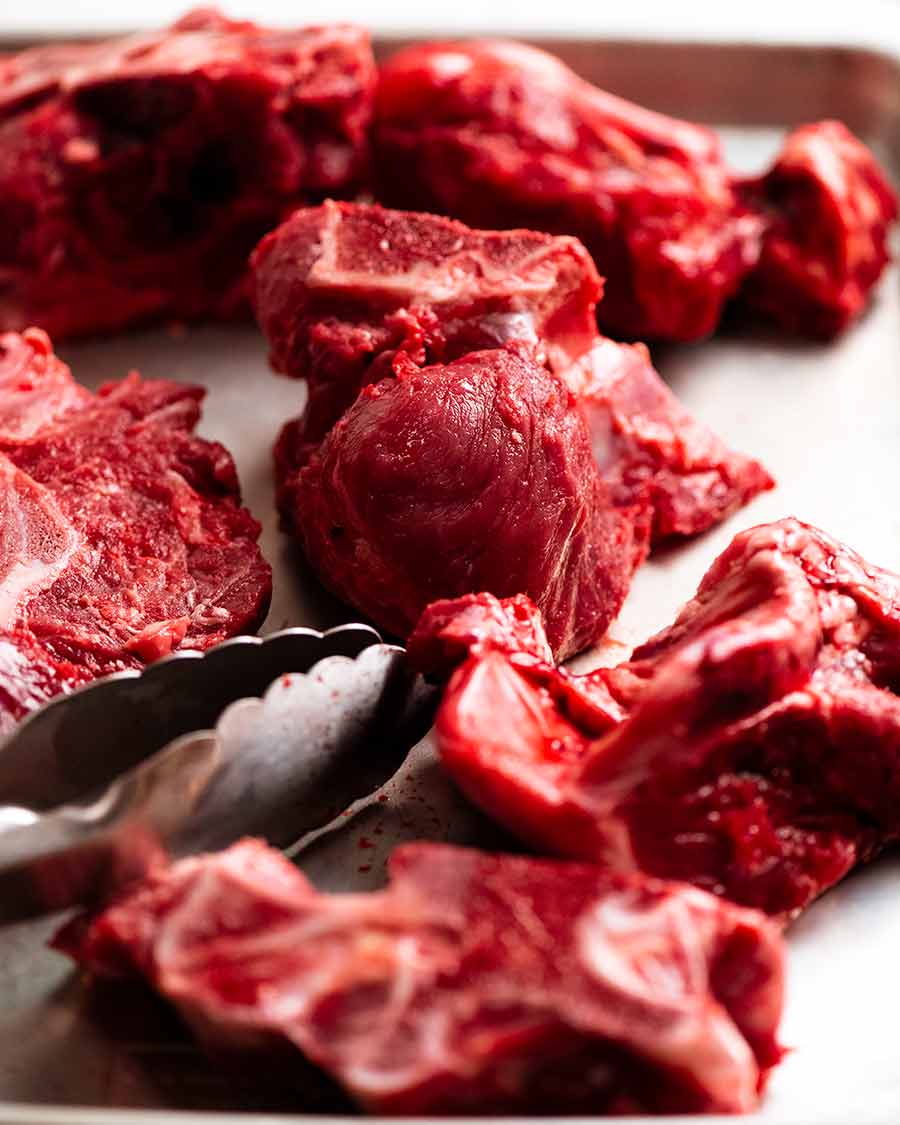
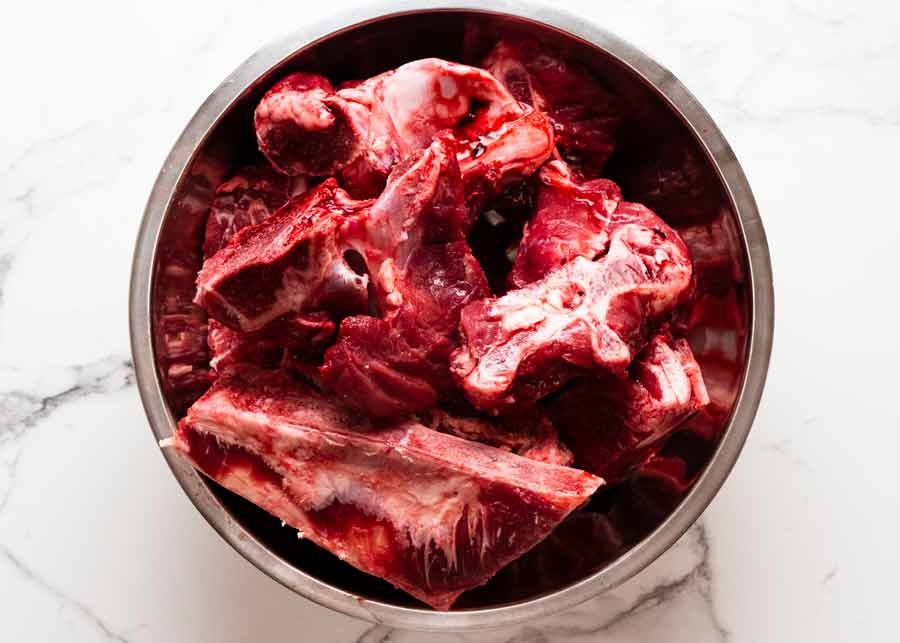
In addition to bones, we also want aromatics which add character, deepen the flavour, add a touch on of sweetness and too provide some color. Here'due south what I utilize:
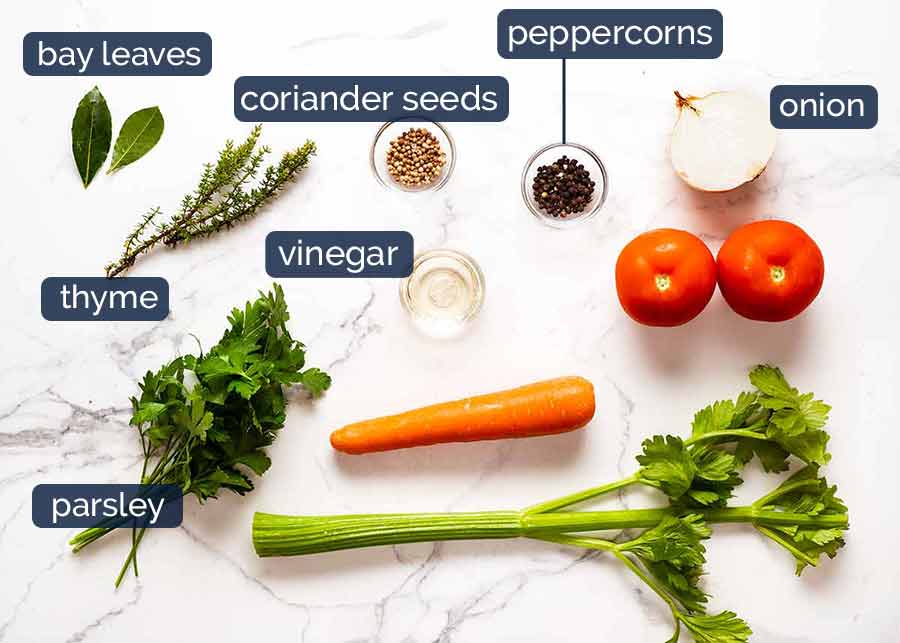
-
Bay leaves, thyme, parsley, blackness peppercorns – Herb and spice aromatics, fairly standard;
-
Onion, celery and carrot – Again, familiar edifice-block ingredients in the stock which add subtle sweet and flavour;
-
Tomato – Something you don't see in the most basic beef stock recipes, this adds a bear upon of sugariness and colour, deepening it to a desirable rich dark brown;
-
Cider vinegar – A great cheffy touch, a fiddling vinegar helps extract nutrients out of the os into the broth;
-
Coriander seeds – Another little cheffy tip, it adds another layer of subtle complexity to the finished stock. You can't separately identify the flavour, only a little taste is all it takes to know you lot've fabricated something special!
Though it takes hours and the manhandling of a (very!) large stock pot, it's actually very straightforward to make this beef stock. Also, the squeamish matter nearly this beefiness stock recipe is that in that location are iii ways to do the ho-hum simmer part:
-
On the stove, the traditional manner;
-
Oven – Entirely hands off, I've even done it overnight; or
-
Tiresome cooker – Assuming you lot take one big enough.
How to make beefiness stock

-
Spread bones out on tray to roast. Roasting develops lots of flavour as well equally darkening the color of the stock;
-
Roast bones for 1 hour at 180°C/350°F, turning halfway, until nicely browned all over;
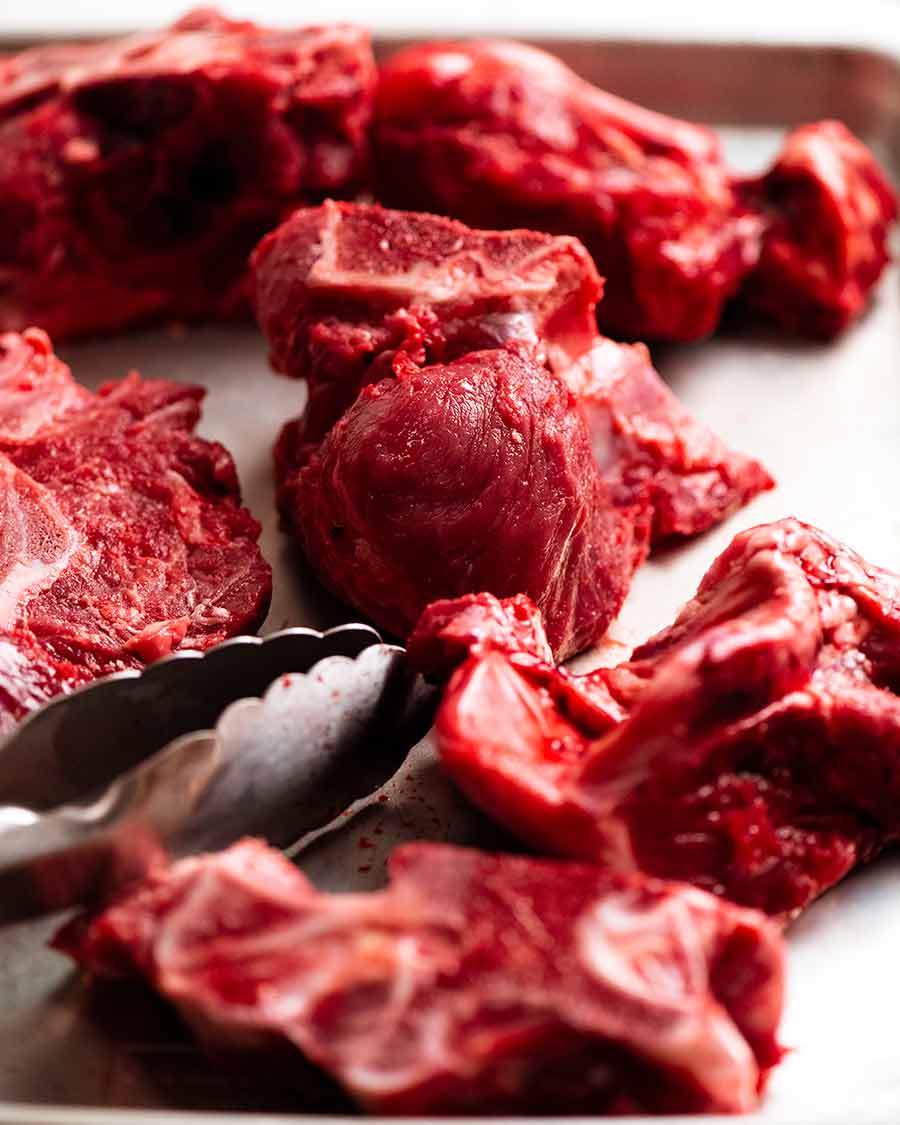
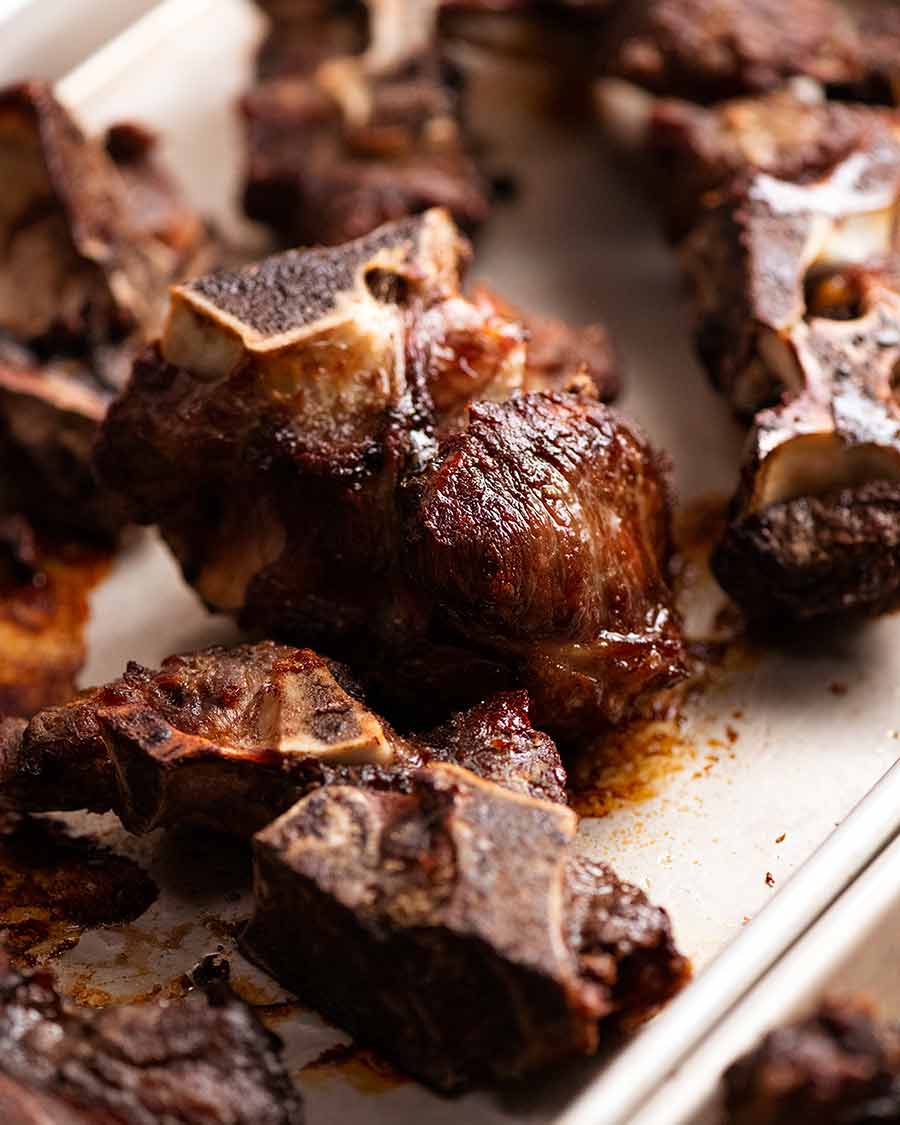

-
Place beefiness basic in a very large stock pot, at to the lowest degree 7 litres / quarts;
-
Add together the herbs and vegetables, and 3 litres of water to just cover the bones. Pack the bones and vegetables down then you lot minimise the amount of water required. Nobody wants to end upwardly with a watery beef stock!
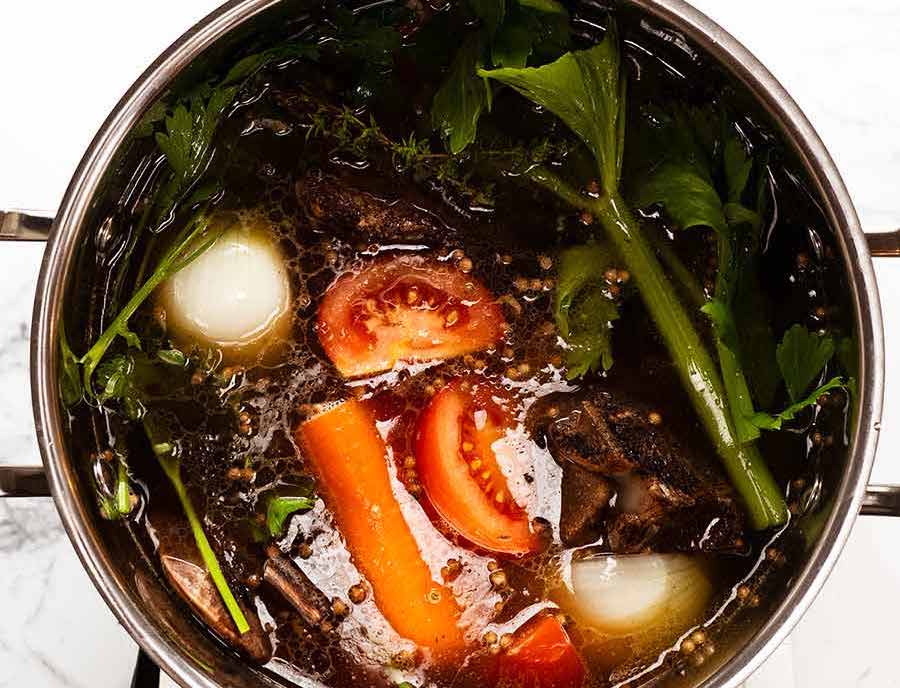

-
Deglaze the pan – don't waste the precious drippings on the tray, information technology's free flavor! Popular the tray on the stove, add together a splash of water, and every bit information technology simmers the drippings volition dissolve into the water. Y'all could too practice this in the oven;
-
Scrape pan juices into the pot;

-
3 – eight hour simmer on stove – Simmer stock on the stove, for a minimum of iii hours and ideally upwards to 8 hours. Stove is the traditional method, and it's entirely hands-off. The heat should be so low that you only get a little chimera every once in a while, and it doesn't need stirring. Do not simmer or boil to try to speed things upwardly, it will make the stock cloudy.
If you practice the faster, 3 hour simmer … If you choose this pick, which we oftentimes deploy because there aren't many times when I can have a pot of stock simmering away all day, we simmer on a marginally stronger rut level to reduce the water faster. In addition, nosotros reduce the stock to concentrate the flavour afterward straining it.
The flavour departure between 3 and 8 hours? Well, of course an viii hour simmer yields a better result. But practicality comes into play here, and while the extra 5 hours does produce an even amend result, a 3 hour simmer volition still give you an exceptional stock;
-
Oven or irksome cooker option: Alternatively, y'all can cook it in the oven for viii hours or even overnight (my record is 15 hours – it was a magnificent batch!!), OR in the slow cooker for 8 hours on low.
This is what the stock water level looks like afterward 8 hours on the stove. The water level should reduce from around the 5.75 litres / quarts mark to around 4 litres (noting this is counting the bones etc still in the water):
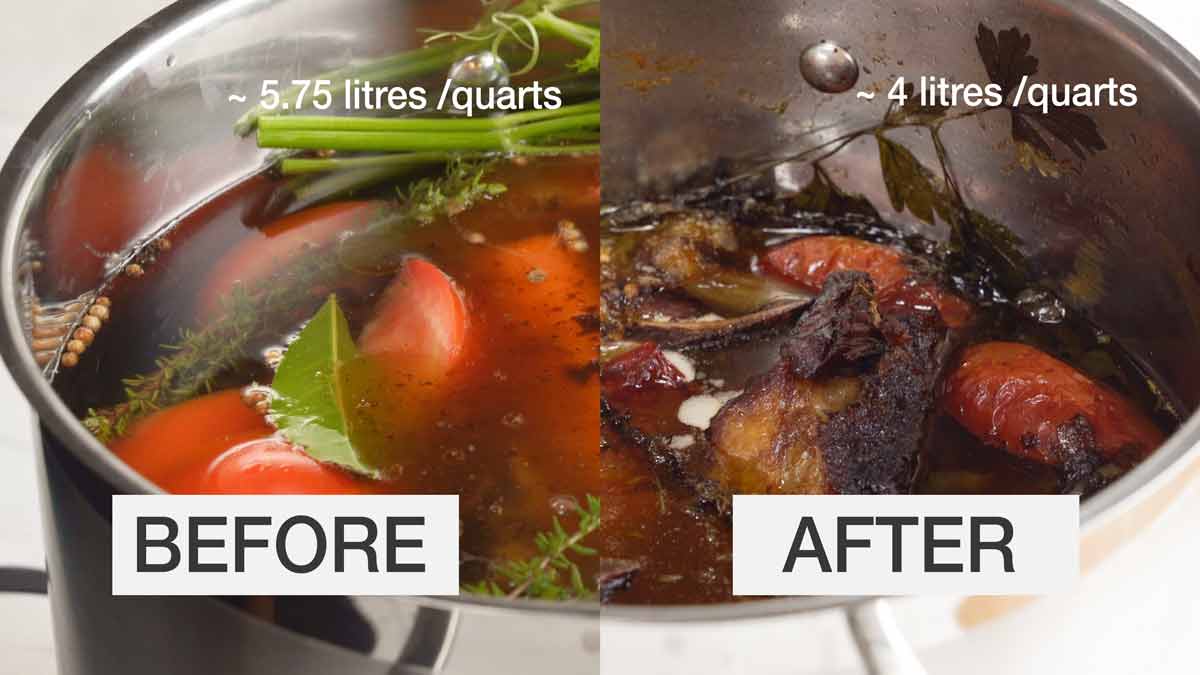
Straining, storage and using
In one case the stock has reduced, it's a matter of straining, discarding excess fat then storing for use!
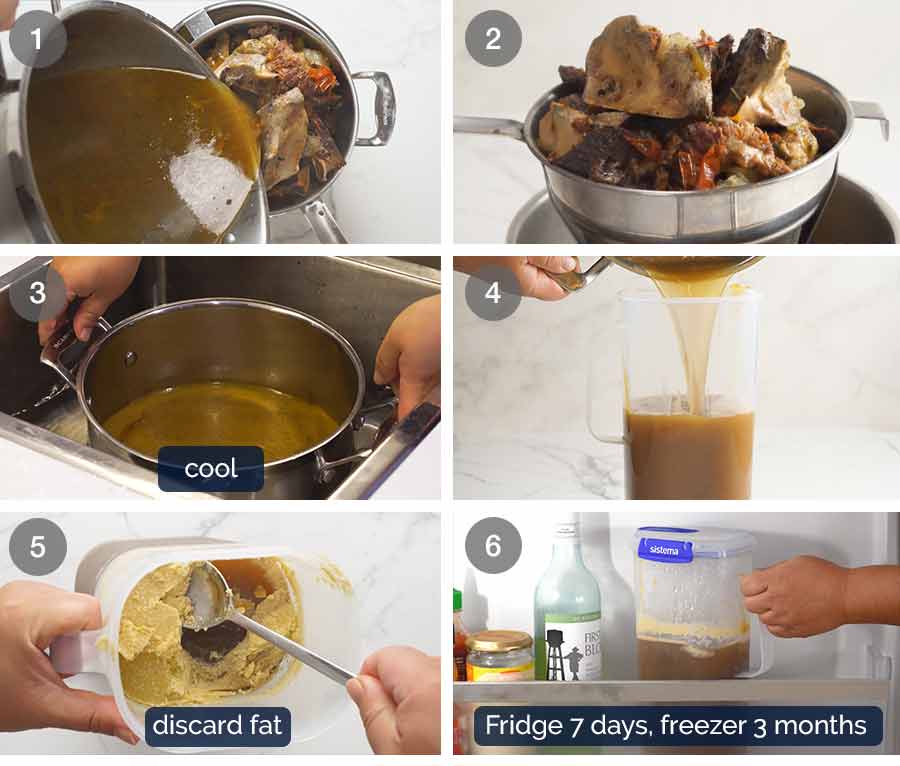
-
Strain – Fish out bones, then strain stock through a fine mesh colander / strainer into a large bowl or clean pot;
-
Yield: ~ 1.three – 1.half dozen litres/quarts – Let the vegetable matter sit there in the strainer for a few minutes to excerpt as much liquid as possible. You should have effectually 1.5 litres / quarts of liquid. After discarding the backlog fatty (subsequently footstep), at that place should be around 1.25 litres / quarts of stock;
-
Cool rapidly by sitting the uncovered pot in a sink full of cold tap water. Change the h2o every 20 minutes or and so as it heats upwards, and it should take around 1 hour 15 minutes to cool to room temperature (effectually 21°C/70°F).
It's important to absurd quickly to foreclose bacteria from growing (they love cosy warm environments!) so we can get it in the fridge ASAP. Never put a big hot pot of stock in the fridge otherwise you will significantly raise the internal temperature of the fridge – that's bad!
-
Refrigerate – Transfer to a suitable storage container – I use a jug – then refrigerate;
-
Remove surface fat – Once it has fully chilled in the fridge, the fat floating on the surface will solidify into a white mass. Use a large, flat spoon to advisedly scrap it off and discard.
This is what beef stock looks like when chilled and the fatty has been removed. It solidifies into a jelly because of the gelatin. Gelatin is what gives the stock that fine-dining eating house, rich mouthfeel. Store bought stock is always liquid because it has little gelatin.
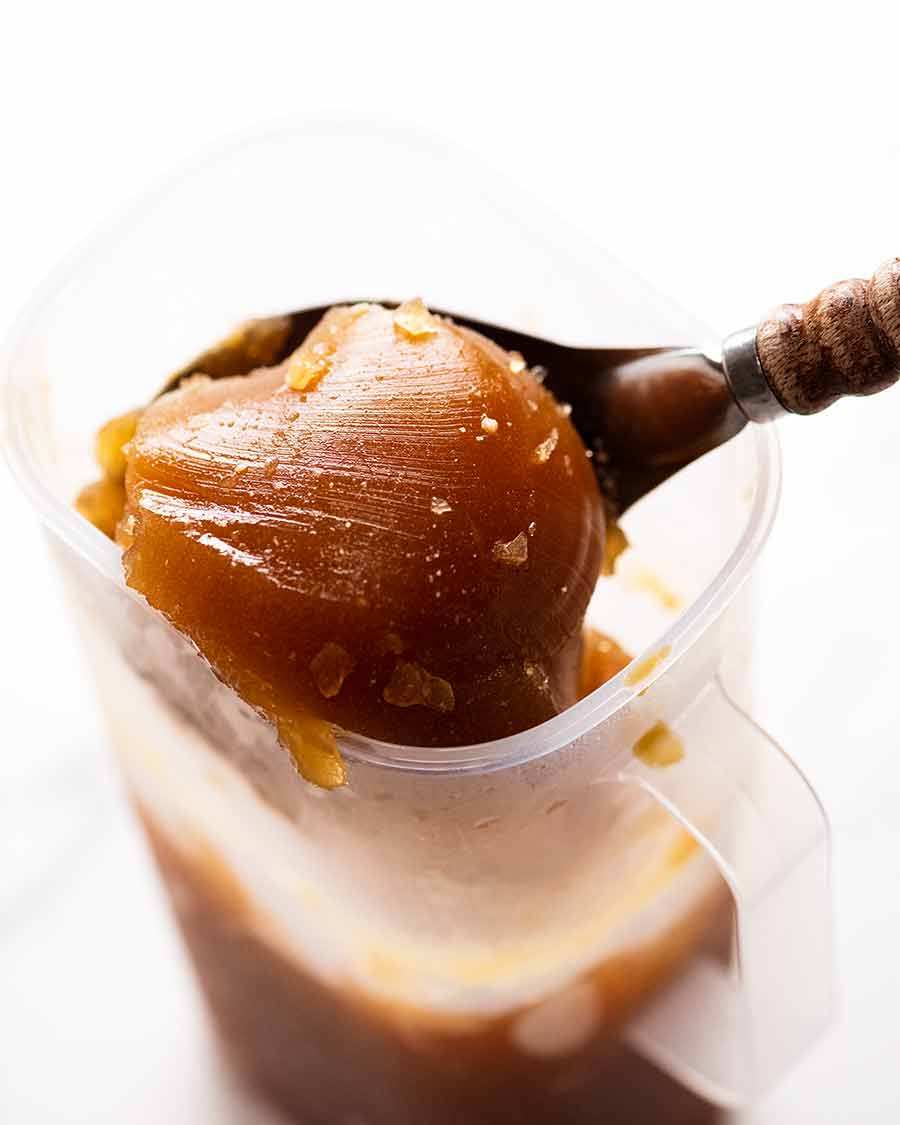
-
Done! Your stock is at present done and gear up for apply! It will keep in the refrigerator for 7 days (I've been told by a reliable source x days is ok, just I say up to vii to err on the side of caution). Else, it tin freeze for upward to three months.
I like to store stock in 1- or 2-cup portions, labelled, in the freezer.
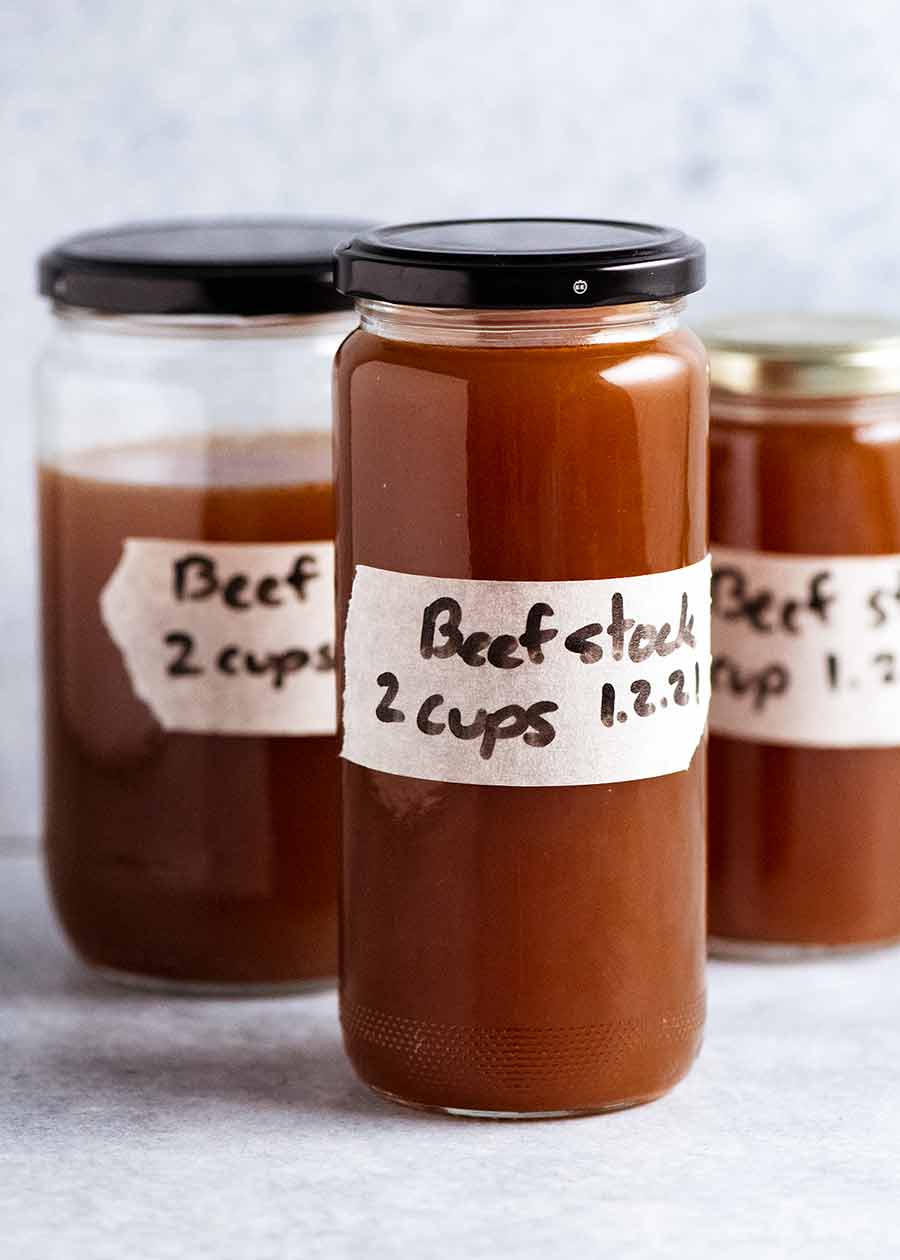
How to use homemade beef stock
To use homemade beef stock, you can either reheat in the microwave or on the stove to return it to a liquid and so information technology tin can be measured out. It melts very chop-chop – literally in a minute or ii.
Information technology can be added direct into dishes in common cold jelly class too. For me, it's just a question of whether I need to measure it or not – it's harder to accurately measure out jelly!

What to use bootleg beefiness stock for
Employ homemade beef stock for whatever recipe that calls for beef stock or beefiness goop. Your finished dish volition be multiple times better than any version fabricated using store bought, with a far richer, deeper flavour and none of that undesirable artificial edge that store bought beefiness stock has.
You volition proceeds exceptionally good results when used peculiarly in irksome-cooked dishes such every bit stews, besides as soups, sauces and gravies (obviously or mushroom!).
Here are some suggestions:
IMPORTANT: Salt aligning when using!
The only matter to note with homemade stock is that you will need to add more common salt to whatever dish you're making. This is because most recipes – including mine – presume store-bought beef stock. Store-bought stock is salted, whereas home-made is unsalted. Therefore, you demand to compensate for this divergence.
As a rule of thumb, you will demand to add 1/3 teaspoon of cooking or kosher salt for every one cup of homemade beef stock in order to have the aforementioned level of salt as low sodium store bought stock.


And with that, I'grand done! The kickoff of a series of homemade stocks that I plan to share.
Next up, fish stock! – Nagi x
Watch how to go far
Subscribe to my newsletter and follow along on Facebook, Pinterest and Instagram for all of the latest updates.
Servings one.5 litres / quarts
Tap or hover to calibration
Recipe video above. This is a classical French-way recipe for homemade beef stock. Information technology's vastly superior to any store-bought stock, and is ane of the main things that distinguishes home and restaurant cooking.
Information technology takes fourth dimension to brand, but if you truly want the all-time, information technology's worth it!
Makes: one.25 – ane.5 50 / quarts stock (5 – 6 cups), ready use store-bought forcefulness, UNSALTED. Add together 1/3 tsp salt for each 1 cup (250ml) homemade beef stock to match shop-bought low sodium beefiness stock.
Other bootleg stocks: chicken stock | vegetable stock
- two.5 kg / v lb meaty beef bones , dorsum and neck preferably, plus one marrow bone for richness (or knuckles) (Note 1)
- 1 carrot , unpeeled, cut in half
- 1/2 onion (brownish or xanthous), peel and cut in half
- 2 tomatoes , cut into quarters (keep seeds in) (Note 2)
- 1/2 tbsp coriander seeds (Note ii)
- 1 tbsp apple cider vinegar (Note three)
- 1/2 tbsp black peppercorns
- i celery stem , cutting in half or thirds (leaves on ok)
- 2 bay leaves , fresh (or 1 dried)
- two thyme sprigs (or 1/2 tsp dried leaves)
- 12 parsley sprigs , if yous accept it (non essential)
- 3 litres/quarts water , cold tap water
Roast bones:
-
Preheat oven to 220°C/430°F (200°C fan).
-
Spread bones out beyond 2 baking trays. Roast for 1 hour, turning at thirty minutes, or until very well browned.
-
Drain and discard backlog fat, if any.
-
Place bones into large stock pot (7 litres/vii quarts+ capacity)
Deglaze trays:
-
Place tray on stove, plow onto medium. Add 3/4 cup water. When it comes to a simmer, showtime scraping the tray. The drippings (fond) on the tray will loosen and deliquesce into the liquid.
-
In one case most of the drippings are removed from the base, scrape all the liquid into the pot. Repeat with other tray.
Simmer stock:
-
Add together remaining ingredients into the pot. Kickoff with 3 litres of water, then squish the bones etc downwards to fit snugly in the pot. Add together more than water if needed, to just encompass the bones (ingredients will collapse a fleck as stock cooks). The water quantity depends on shape of os and pot – my water level came to 5.75 litres/quarts marker on pot.
-
Eddy then simmer: Bring to a boil on medium high, so plow downwards to low so it's simmering ever and then gently, with only a small chimera bursting every at present then.
-
Remove surface scum: Scoop off any surface scum using a ladle and discard.
-
Simmer for 8 hours on very low, no lid. Liquid level should reduce to around 4 litres/quarts for all – if not, but reduce afterwards straining (Step three under Strain & Cease).
-
Other methods:
– Stove three hours on medium-depression (very gentle simmer, with lid cracked)
– oven (chapeau on) for 8 to 10 hours at 120°C/250°F (100°C fan). Water level will only reduce by about 500ml / 0.5 qt. Strain then rapid boil to reduce to i.v lt / 1.five qt.
– irksome cooker 8 to 10 hours on depression. Reduce subsequently straining to 1.5 lt / 1.5 qt.
Strain & end:
-
Strain: Fish out most bones. Strain stock with remaining vegetables through a fine mesh colander / strainer ready over a big pot or bowl. Get out strainer for a few minutes to let information technology baste.
-
Absurd to room temperature: Set stock pot or basin in sink filled with cold water. Leave stock to cool for around 1h fifteen mins, irresolute h2o every twenty mins or and so as it gets warm.
-
Measure stock volume: Pour stock into a vessel to measure volume – information technology should be between around 1.3 – 1.7 litres/quarts. If it's much more, reduce on the stove, otherwise stock flavour volition be too weak.
-
Refrigerate stock. When fat has solidified on surface, carefully scrape off with a large spoon and discard. Yous should take 1.25 – 1.5 50/Qts remaining.
-
Prepare! Beefiness stock is at present ready to use! This stock is equivalent in strength to shop-bought stock, and so information technology can be used i:1 in whatever recipe calling for beef stock.
-
Common salt aligning: Homemade stock is unsalted whereas store-bought stock is salted. Add 1/4 tsp common salt for every 1 cup bootleg beef stock (250ml) to match the salt level of store-bought low sodium beef stock.
-
To use: Common cold stock has a jellied consistency (Note 4). It takes barely a minute to turn liquid on a medium high stove, or microwave. You lot tin as well just add it in jelly form straight into dishes, but sometimes y'all may need to liquify it to measure out.
one. Bones – Be sure to utilise meaty bones considering meat = flavour. If y'all employ meatless bones, the stock will exist very banal.
It's also good to include a marrow bone if yous can get information technology (ie. the basic split in half to reveal the fatty marrow inside) as this adds a some valuable richness into the stock. Include this in the 2½ kg / 5 lb.
Australia – The packs sold as "Beef Soup Bones" at grocery stores are fine to employ, they are pretty meaty. But they are more expensive than buying from butchers. Do not apply the actually fatty bones sold every bit "brisket bones". All fat, no meat!
2. Coriander seeds and love apple – These are not usually seen is very traditional stocks, but are a terrific cheffy tip that elevates the stock. The tomato adds sweetness and makes the stock colour even richer in flavour, and the coriander seeds adds a bear on of actress savouriness. Not the end of the world if y'all don't take them.
3. Cider vinegar – Helps extract nutrients out of the bones.
iv. Stock consistency when common cold is jelly similar due to gelatin. Gelatin gives the stock richness that yous don't get in liquid store-bought stock.
5. Methods of cooking / reducing liquid – you demand to ensure the bones are fully covered in water to ensure the flavour of the beefiness infuses into the h2o, so the volume of water required will differ depending on the shape of bones.
Later the required cook time, if the strained stock has not reduced to the target quantity of 1.3 – i.seven litres/quarts, then strain and rapid boil until you lot accomplish the target amount.
- Very low stove for eight hours with the lid off should go close to the target liquid quantity – 4 litres / 4 qts with the bone in, one.3 – 1.seven litres/quarts after straining;
- Medium low stove for 3 hourswith the lid cracked should as well get to the target stock quantity;
- Ovenfor 8 – 10 hours will but reduce virtually 500ml / 0.5 qt so information technology will need to exist rapid boiled after straining; and
- Irksome cooker will barely reduce at all then will need to be reduced.
Practise not rapid boil with the bones, information technology volition make the stock cloudy.
6. Leftover meat on basic – the meat left on the basic don't take much season because it's in the stock! However, it seems such a waste non to pick it all off, so I always do and Dozer get it for dinner. 🙂
If you want to employ information technology, I'd recommend adding flavour. Y'all could toss with a BBQ sauce or other sauce, and use equally pulled beef. Otherwise, you lot could just pan fry in butter and garlic.
7. Storage – seven days in the refrigerator, or three months in the freezer. I like to portion into usable quantities (1 cup, ii cups), label and then freeze in jars.
viii. Diet – Calculated for entire batch of stock.
Calories: 121 cal (half-dozen%) Carbohydrates: 27 g (9%) Protein: five one thousand (10%) Fat: 1 g (2%) Saturated Fatty: 1 g (6%) Sodium: 66 mg (three%) Potassium: 1047 mg (xxx%) Fiber: 9 g (38%) Carbohydrate: 12 g (xiii%) Vitamin A: 13387 IU (268%) Vitamin C: 61 mg (74%) Calcium: 125 mg (thirteen%) Iron: 3 mg (17%)
Life of Dozer
Dozer agrees that meaty bones are all-time.
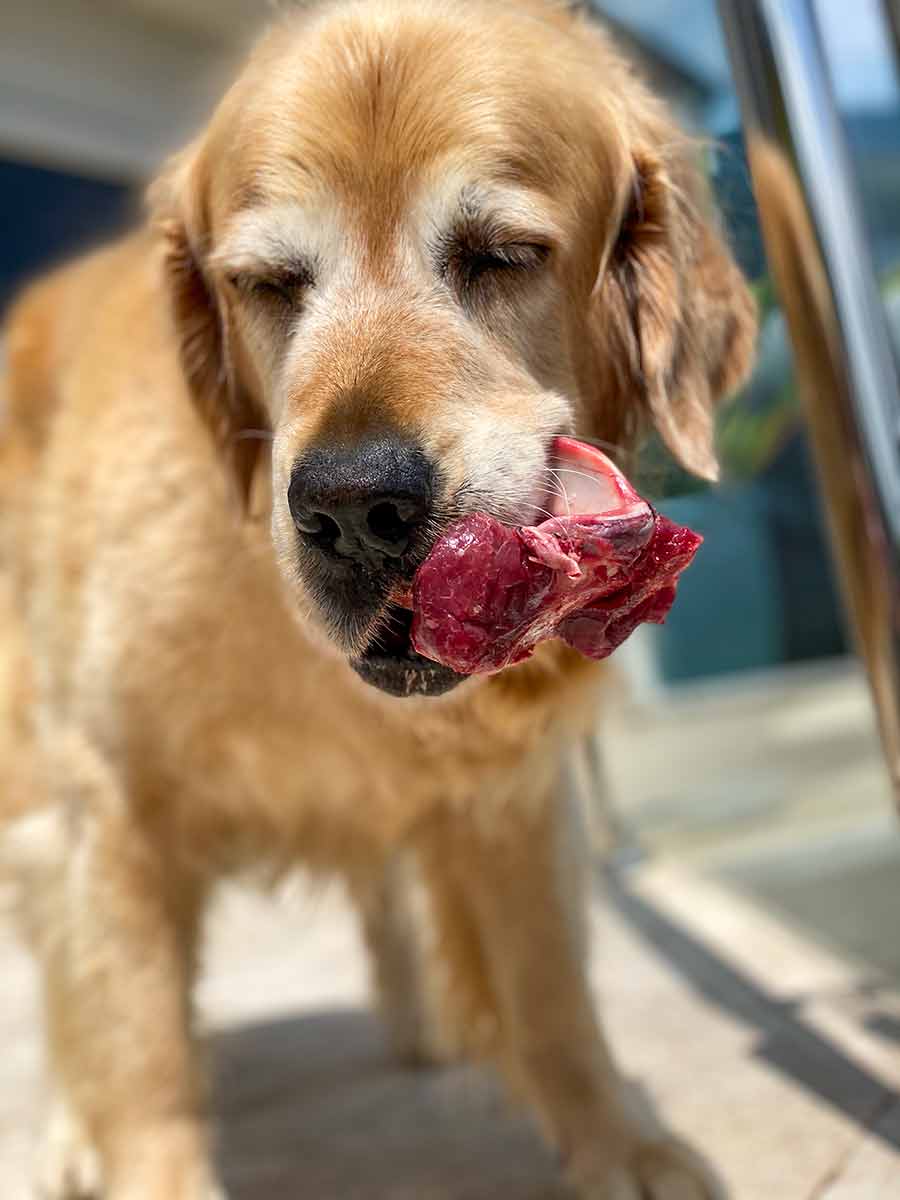
austinanciverivens.blogspot.com
Source: https://www.recipetineats.com/homemade-beef-stock/
0 Response to "How to Use Beef Bones for Stock"
Post a Comment